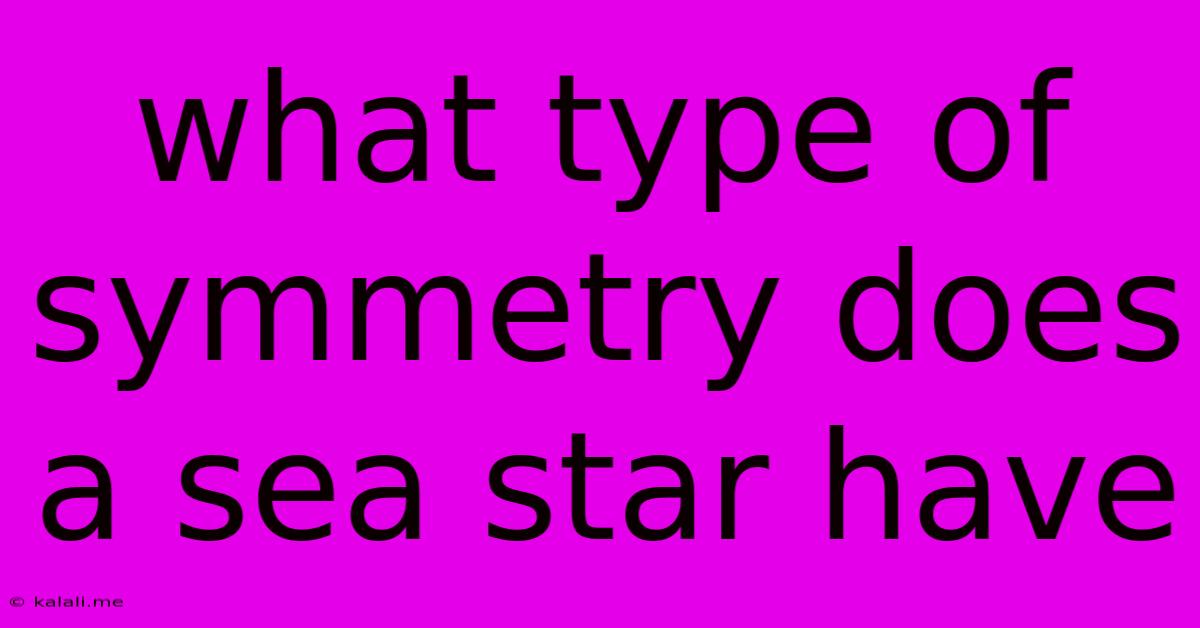What Type Of Symmetry Does A Sea Star Have
Kalali
May 10, 2025 · 3 min read

Table of Contents
What Type of Symmetry Does a Sea Star Have? Unraveling the Radiality of Echinoderms
Sea stars, also known as starfish, are fascinating creatures found in oceans worldwide. Their unique appearance immediately sparks curiosity, particularly regarding their body structure and symmetry. This article delves into the specific type of symmetry exhibited by sea stars, exploring the biological mechanisms behind it and its significance in their survival.
Understanding Symmetry in Biology:
Before diving into the sea star's symmetry, let's establish a basic understanding of symmetry types in the biological context. Two main types are commonly observed:
- Bilateral Symmetry: Organisms with bilateral symmetry can be divided into two mirror-image halves along a single plane. Humans, for example, exhibit bilateral symmetry.
- Radial Symmetry: Organisms with radial symmetry have multiple planes of symmetry, radiating from a central point. Think of a pizza—you can cut it into numerous equal slices from the center.
The Radial Symmetry of Sea Stars:
Sea stars possess radial symmetry, specifically pentamerous radial symmetry. This means their bodies are organized around a central axis, with five arms or rays extending outwards. Each arm contains a similar set of structures, including tube feet, sensory organs, and parts of the digestive system. While seemingly simple, this type of symmetry is highly efficient for their lifestyle.
Advantages of Radial Symmetry for Sea Stars:
- Ambush Predation: The radial arrangement allows sea stars to approach prey from any direction, enhancing their ambush predation strategies. Their tube feet, arranged along the arms, provide a powerful grip for capturing and consuming their meals, such as clams and mussels.
- Environmental Awareness: Sensory organs distributed throughout the arms allow for a 360-degree awareness of their surroundings, crucial for detecting predators and locating food sources in their marine environment.
- Regeneration: Sea stars' remarkable ability to regenerate lost arms is intimately linked to their radial symmetry. Each arm possesses the genetic information to potentially regenerate a complete organism. This adaptability is a significant advantage for survival in potentially harsh environments.
- Movement and Locomotion: The water vascular system, responsible for locomotion, is also radially arranged. This enables them to move efficiently in all directions, crucial for navigating their rocky habitats and searching for food.
Exceptions and Variations in Sea Star Symmetry:
While pentamerous radial symmetry is the defining characteristic, slight variations exist across different sea star species. Some species might show minor asymmetries due to injuries or regeneration processes. However, the overall radial arrangement remains consistent.
Distinguishing Radial from Bilateral Symmetry:
It's essential to differentiate between radial and bilateral symmetry. While some organisms might exhibit aspects of both, sea stars are definitively radial. The lack of a distinct head or tail, along with the repetitive structure of their arms, further emphasizes their radial organization.
Conclusion:
The radial symmetry of sea stars is a key element of their unique biology and evolutionary success. This body plan perfectly adapts them to their specific ecological niche, contributing to their efficient predation, environmental awareness, regenerative capabilities, and overall survival in diverse marine environments. Their intriguing symmetry serves as a captivating example of the remarkable adaptations found in the natural world.
Latest Posts
Latest Posts
-
1 72 Metres In Feet And Inches
May 10, 2025
-
The Most Abundant Gas In The Universe
May 10, 2025
-
7 Is What Percent Of 15
May 10, 2025
-
Round 0 234 To The Nearest Hundredth
May 10, 2025
-
Least Common Multiple Of 14 And 35
May 10, 2025
Related Post
Thank you for visiting our website which covers about What Type Of Symmetry Does A Sea Star Have . We hope the information provided has been useful to you. Feel free to contact us if you have any questions or need further assistance. See you next time and don't miss to bookmark.